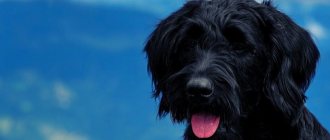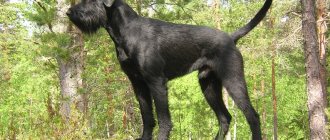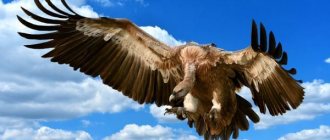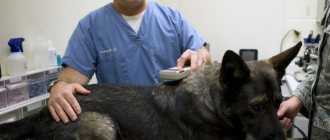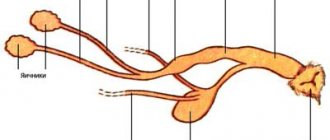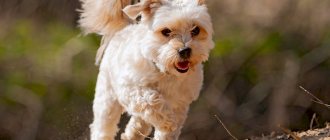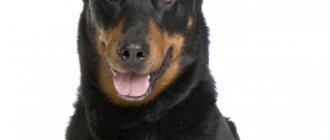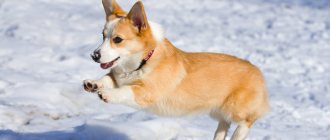Forum thread
Age:
1.5 years old
Gender:
female
Documents:
veterinary passport
City:
Moscow (relocation possible)
Contacts:
+7-909-962-3000 Mila A young undocked, unsterilized mixed-breed female Giant Schnauzer Bora is looking for a home.
Medium-sized with a hard coat. Very attached to people, good at making contact. Knows how to play with toys. Energetic - a bitch with a real big character. She doesn’t spoil the house, she asks to go outside. Drives well in the car. The relationship to cats is unknown. In the heat of play, a fight can start with dogs. the GIANT SCHNAUZER BANK will be happy to take part in it under the partial care of the Schnauzer Assistance Fund. Topic on the forum
Age:
4 years
old Gender:
male
Documents:
veterinary passport
City:
Moscow
Contacts:
+7-926-533-2356 Anya Due to family circumstances (illness of the owner), the Giant Schnauzer Bank (pet name Benya) is looking for a home Age: 11/19/14 (4 years) Gender: male (not neutered) Documents: veterinary passport City: Moscow Height at withers 77 cm, weight 50 kg Bank loves and wants to communicate with people.
He loves affection and the human voice very much. He is very friendly and sociable, but is wary with children. Benya is completely healthy, vaccinated. He is calm about visiting a groomer's salon. Travels well in a car over long distances. Accustomed to living in an apartment and walking twice a day (not suitable for keeping in an enclosure!) He eats dry food. Treats other dogs adequately, ignores cats on the street on command, and is friendly with the house cat. Completed a UPG (controlled city dog) training course. GIANT SCHNAUZER MONYA under the care of the Schnauzer Assistance Fund Forum topic
Age:
4 years old
Gender:
male
Documents:
veterinary passport
City:
Chekhov, Moscow Region (relocation possible)
Contacts:
+7-909-962-3000 Monya is a medium-sized wire-haired male who came to us from the Rostov shelter.
He is very person-oriented, reaches out, catches the eye. Not accustomed to interacting with other dogs, may be aggressive with them. Monya spent the first part of his life on a chain and is now learning to live an ordinary, homely life. Despite the sad beginning of her life, Monya loves children and enjoys communicating with them. GIANT SCHNAUZER PRINCESS under the full care of the Schnauzer Assistance Fund Forum topic
Age:
about 6 years old
Gender:
female
Documents:
veterinary passport
City:
Moscow (relocation possible)
Contacts:
+7-909-962-3000 [email protected]
The Giant Schnauzer bitch Princess is looking for good hands.
Age about 6 years. Sterilized. Non-aggressive. She does not conflict with other dogs unless they encroach on her food. It is bad to stay at home alone, so it is preferable to live in the countryside with the opportunity to leave the dog in a warm enclosure while the owners are away. If you live in an apartment, then at first there must be someone at home. Walking on a leash is required outdoors. If in a country house, then there should be a fence without holes - the craving for freedom remains from a past life. GIANT SCHNAUZER CHAH DE GRAF DIMAYORK under the full care of the Schnauzer Assistance Fund Forum topic
Age:
8 years old
Gender:
male (neutered)
Documents:
veterinary passport, pedigree
City:
Moscow (relocation possible)
Contacts:
8-926-671-00-97 Ksenia [email protected]
A young Giant Schnauzer, male, age 8 years, is being adopted.
Nickname: Shah De Graf Dimayork. The color is black, the correct breed coat, the ears and tail are not docked. No health problems, neutered, vaccinated. Very strong and energetic, needs long walks and active pastime. He is friendly and sociable towards people, but due to increased excitability he can be uncomfortable for children and the elderly. Being alone at home can cause anxiety, so it is advisable to leave him in a cage while you are away. He does not show much interest in other dogs, although, of course, there may be conflicts with male dogs. Can chase cats. Available only for country living with the possibility of long active walking. GIANT SCHNAUZER INNOCENTY under the full care of the Schnauzer Assistance Fund Forum thread
Age:
about 10 years
Gender:
male
City:
St. Petersburg (relocation possible)
Contacts:
8-911-941-2205 Irina [email protected]
An adult male Giant Schnauzer (possibly a close mix) Innokenty is being placed in good, experienced hands. Kesha is about 10 years old, her ears and tail are cropped. Small, but strong, brutal and active. Innocent is a man in full bloom and with a serious character. Likes to run (after sticks and bottles). He loves to communicate with his relatives, and is selective with male dogs (he can provoke conflict, but without waiting for an answer, he calmly steps aside). It will be a great pleasure to spend all your time with a person. Without a person, Innocent feels very bad. He really needs attention and affection. He simply melts in the arms of a person. The seriousness of the character lies in the fact that he does not tolerate familiarity in relation to himself. Everything should be clear and precise. If you become an unconditional leader for Kesha, explain to him the rules of behavior in your home, treat him with respect and care and spend the maximum amount of time in his company, then Innocent is definitely your dog, friend and reliable guard.
schnauzer-help.ru
The entire history of the existence of the Giant Schnauzer breed is a living illustration of the appearance of this dog. Designed as the ideal jack-of-all-trades, Risen is the ultimate companion for those who appreciate and understand the working qualities of service dogs. Tirelessness, remarkable strength and speed of work, intelligence and the desire to form one’s own opinion on everything are the main characteristics of the Giant Schnauzer.
Modern Giant Schnauzers, despite their somewhat exaggerated appearance relative to older dogs, have retained the best qualities of this breed. They are active, always excel in sports with dogs, and this allows them to feel happy next to their owners. The incredibly attractive and elegant appearance of these dogs should not be the only reason to have them in your home. Risen dog for sport and work. She is a universal soldier, capable of following a trail for a long time and recklessly, instantly overtaking and putting down an intruder, towing a loaded sled, carrying tourist or medical equipment on her back, accompanying mounted police, working in a search and rescue service or in a water rescue team.
Devotion to the owner and reliability distinguish the modern service Giant Schnauzer. However, you should not expect miracles from your dog - it obeys only those who have been able to prove their right to control its fate. Weak, insecure owners will quickly find themselves under the heel of an intelligent and powerful Risen, especially if they decide to adopt a male dog. A Giant Schnauzer raised without proper control will become a dog that is dangerous not only to others, but also to the owners themselves. Without an outlet, the energy of these dogs can become destructive. Those who get a service Giant Schnauzer without the slightest idea of what this dog is like most often find themselves in a difficult situation, as they are unable to train and control their dog.
A self-confident, active and powerful owner will find in Risen what he values and loves in dogs. This breed is usually owned by dog breeders who plan to engage in sports with dogs, professional dog guards, for whom the speed and tirelessness of the dog, as well as its ability to make independent decisions, are important.
The Giant Schnauzer will enjoy any work with its owner - whether it be learning how to overcome obstacles in agility classes, tracking, search or rescue work. Dogs of this breed are excellent swimmers, capable of running after a bicycle or horse for a long time, and in winter they are happy to tow a skier, sled children or carry loads. A police officer can catch up with a motorcyclist, easily resists two attackers, and is able to learn how to fight an armed enemy.
From a young age, the Giant Schnauzer puppy wants to learn. The speed at which dogs of this breed learn new skills is amazing. They are happy to fetch objects, already at three months they learn to sit, stand and lie down on command, and quickly develop endurance. Raising a Giant Schnauzer will require the owner to have a high reaction speed, tirelessness and ingenuity - these dogs do not really like boring repetitions and often try to modify skills at their own discretion. It is impossible to force them to repeat the same thing an infinite number of times. The dog turns away, yawns, demonstrating indifference to what is happening on the site with its entire appearance. At the same time, changing the type of incentive allows you to instantly put Risen back into work.
Another distinctive feature of the Giant Schnauzer is its ability to instantly switch from resting mode to working mode. One moment the dog was calmly dozing under your feet - and the next second it flies towards the Frisbee or the intruder. The desire to be close to the owner all the time forces the working Giant Schnauzer to independently learn a lot of useful skills and habits. This dog is happy to bring mail or its equipment to the owner, is able to learn the names of various plumbing tools, and help with pulling heavy objects. Some dogs enjoy going hunting with their owners. Fearless Rizens easily learn even to jump from a parachute, serving together with their owners - paratroopers.
It should be noted that years of ornamental breeding could not but affect the working qualities of some lines of Giant Schnauzers. Over time, it became clear that appearance alone could not become the highlight of this breed, however, for some time, breeding went in the direction of improving exclusively the exterior of the Giant Schnauzer. This led to the appearance of elegant dogs with soft fur, which gradually lost the distrust of strangers, reaction speed and other working qualities characteristic of the service breed. Therefore, the choice of a dog for sports and police work is now possible only in those kennels that have constantly focused on breeding working dogs and have selected in this direction.
Another point that can darken your relationship with Giant Schnauzers is their health. Allergic dermatitis, hip dysplasia, hereditary diseases of the thyroid gland reduce the quality of life of dogs, negatively affecting their working qualities. So finding a working dog also involves tracking the health of your puppy's ancestors, which is usually only done in large professional kennels.
The Giant Schnauzer is a dog for those who value an unspoiled character, an active lifestyle, endurance and health. This is what saved the breed from the negative influence of changing fashion. The fact that Rizens never became a fashionable breed allowed them to maintain their unique appearance and moral qualities, remaining a dog for the elite. An attempt to turn them into companion dogs, good-natured and loyal to people, did not add popularity to the breed, since the main idea behind its creation was precisely its unique working qualities.
vetsystem.ru
Appearance and characteristics of the breed
Let's start with the fact that "Rizen" is almost forgotten now. And 20-30 years ago, these worthy dogs were found in abundance in large cities. Today they are kept by true lovers of the breed; for the most part, Giant Schnauzers are in the service of government agencies.
The Giant Schnauzer is a mixture of an interesting exterior and crazy working qualities. According to FCI standard No. 181 (updated 05/25/2021), the typical representative of the breed is large, strong, energetic and agile. The appearance of such a pet inspires respect from others; few people want to get acquainted with dog teeth.
The calling card of the exterior is bangs, mustache and beard. Under the bangs, the eyes are practically invisible, which gives the impression that the “Rizen” does not see anything. However, the impression is deceptive, the dog sees perfectly and is in a constant “state of high alert.”
This “combat readiness” is a feature of the breed. The Giant Schnauzer seems like such a bumpkin, but appearances are deceiving. A typical representative of the breed is cunning when it comes to inventions, will definitely test the owner’s strength (some dogs test their entire lives), will smile at a stranger so that he instantly retreats from the path of the Risen and invite a passing cat to play.
In general, the Giant Schnauzer is a dog for active, inventive and wise people. Choosing such a friend for people who are inactive, elderly or busy is a mockery of both themselves and the animal.
Read also
Zoogeographical areas
Zoogeographical Regions I now proceed to describe the faunal features of the six large biological regions; after this I will discuss the probable changes in them during the last geological periods in accordance with the above
Regions of the New World
Regions of the New World In the Western Hemisphere we must first of all concern ourselves with the consideration of the Nearctic region, or the temperate part of North America, the modern and ancient zoological relations of which to other parts of the world are of extreme interest. If
Fish body shape
Body shape of fish The body shape of fish is so diverse that it is impossible to give it a general description. When we pronounce the words “bird” and “beast,” we immediately imagine in the first case an animal with wings, in the second – with four legs. And about fish you can only
Body Shape
Body shape The highest height is among the Sudanese and blacks living in the Lake Chad region, in Central Africa, the lowest (150 centimeters) is among the pygmies, also living in Central Africa. Tall blacks live next to the pygmies, eat the same food as them, but are taller than them
2.1 Size and shape
2.1 Size and shape The sizes of neurons can range from 1 (the size of a photoreceptor) to 1000 μm (the size of a giant neuron in the marine mollusk Aplysia) (see [Sakharov, 1992]). The shape of neurons is also extremely diverse. The shape of the neurons is most clearly visible when preparing the drug.
More expensive than your head
More expensive than the head A man would not be fully a man if nature had not also given him testicles. The testicles are paired glands called gonads. Why are there two of them? One is a spare, just in case. When there was no Bible yet, the men of Ancient Rome, taking an oath, put their hand on
2 D. E. HARDING How I Was Headless
2 D. E. HARDING How I Was Without a Head The best day of my life—my second birth, so to speak—was the day I discovered that I had no head. This is not at all a clever literary move and not a witticism designed to arouse interest at any cost. I say absolutely
5.1.1. Head muscles
5.1.1. Muscles of the head The muscles of the head are divided into facial and chewing muscles. The first are distinguished by the fact that they begin on the bones or fascia and end in the skin. Some of the muscles grouped around the natural openings form sphincters (contribute to the narrowing of the opening) or
Diseases of the head area
Diseases of the head region Brain injuries (trauma cerebri). Traumatic brain injuries in dogs can be expressed in the form of concussions, bruises and compression. Causes may include blows to the head with hard objects and blows to the head when falling on hard ground. Concussion
Diseases of the mouth area
Diseases of the oral area Foreign bodies in the oral cavity (Corpora aliena) Foreign bodies in the oral cavity in dogs can be needles, pieces of wire, pins, fish bones and other sharp objects. They become embedded in the tongue, gums, cheeks and palate. The tongue may be ring-shaped
CHAPTER I DEVELOPMENT OF THE HEAD AND ORAL ORGANS OF THE DOG
CHAPTER I DEVELOPMENT OF THE HEAD AND ORAL ORGANS OF THE DOG Veterinary dentistry should be based on knowledge of the development, structure and physiology of the head, and the oral cavity in particular. This allows the veterinarian to present a picture not only
Phylogeny of the head, skull and oral cavity
Phylogeny of the head, skull and oral cavity The head of a dog, like that of any other animal, is a universal container for a large number of organs. In addition to the brain as the center of regulation of the entire organism as a whole, the main sensory organs are located in the head area,
Blood supply to the head and oral cavity
Blood supply to the head and organs of the oral cavity The functioning of any organ or the entire body of an animal depends on the efficiency of their blood supply. This relationship is due to the fact that the flow of blood into the tissues ensures metabolism and humoral regulation
Lymphatic system of the head
Lymphatic system of the head In the process of evolution, a functional addition to the circulatory system appeared in the form of the lymphatic system. Penetrating into all corners of the body, blood must not only ensure the metabolic process, but also monitor its progress at the right level.
Innervation of the head
Innervation of the head The function of the nervous system is to control the activities of various systems and apparatuses that make up the whole organism, to coordinate the processes occurring in it, to establish relationships between the body and the external environment. Nerves penetrate everything
Source
Doctor of Veterinary Sciences Kozlov N.A. Khromova E.V. Clinical case – a bite wound in the head area of a Chihuahua (with 3D tomography). Upon admission to the clinic, the animal was in a depressed state, ataxia was present, but at the same time, when assessing the condition of the cranial nerves, no impairment of their function was found. * Dogs and cats often suffer head injuries. Their consequences may […]
History of the origin of the breed
Giant muzzle - this is how the name “Giant Schnauzer” is translated. The birthplace of the muzzle is Germany, this is known for sure. And then the most interesting thing begins: according to one version, the breed originated in the south of the country, in the areas bordering Switzerland. According to the second version, Giant Schnauzers come from distant settlements in the southeastern part of Germany. And some even claim that the breed originated in Austria, later migrating to the Germans.
The most widespread and secretly accepted version is that Bavaria is considered the homeland of the “Rizens”. Local peasants used a large dog, distrustful of strangers, as a guard of simple property, an assistant in herding livestock, and a personal protector. The ancestors of modern Giant Schnauzers were red, strong and very stern.
Initially, no one was interested in farm dogs: they herd livestock, guard dogs - well, God bless them. As time passed, the noble dogs became interested in the brave dogs: the Giant Schnauzer can be seen in portraits of the Bavarian Princess Elizabeth. And later, at the beginning of the 20th century, giant faces began to appear at exhibitions. The first exhibition, in 1902, did not bring much success to these dogs. But seven years later, almost 30 representatives of this breed shone at the Munich exhibition. Since then, its intensive improvement has begun.
In almost 15 years, breeders achieved such success in breeding that in 1923 the first breed standard appeared.
The appearance of the Giant Schnauzer in the USSR
The history of the development of this breed in our country goes back several decades. The first individuals appeared in the Soviet Union back in the 1930s, but these were only single specimens with which breeding work was not carried out. In the 70s, for the first time, five Giant Schnauzers were brought from Germany, who founded the current livestock in our country.
A domestically produced Giant Schnauzer dog was presented at an exhibition in Moscow in 1974.
Unfortunately, lately, on the streets of our cities, these jet-black handsome men can be seen less and less often. For unknown reasons, interest in the breed is fading, and completely undeservedly. This is an amazing dog - a Giant Schnauzer! The price for them has also decreased, although it is probably not entirely correct to talk about money when we are talking about a faithful and devoted friend. Today we will tell you about these animals. Perhaps this is exactly the dog you have been dreaming of.
Breed standard
FCI standard No. 181 (added 05/25/2021) states:
HEAD: The skull is strong, oblong, the occipital protuberance is not very pronounced. The transition from the forehead to the muzzle (“stop”) is well defined and emphasized by bushy eyebrows. The ears are set high, hanging on cartilages, in the shape of the letter “V”; The corners of the ears are adjacent to the cheekbones. The eyes are medium in size, oval in shape, straight set, dark, with a lively expression. The nose is large, well developed, always black. Jaws and teeth: The upper and lower jaws are strong. Scissor bite, clean, white teeth, in full set (42 pieces).
BODY The topline is slightly sloping from the withers to the base of the tail. The withers are the highest point of the dog's body. The back is strong, durable, short. The loin is short and strong. The short distance between the last rib and the hip gives the dog a compact appearance. The croup is slightly rounded towards the base of the tail. The chest is moderately wide, oval in shape, deep, and when viewed in profile reaches the elbows. The belly is moderately tucked and forms a beautiful curved line along the entire body of the dog. The tail is natural, not docked.
WOOL
Hard, wiry, dense. It consists of an inner layer - thick undercoat and outer, guard hair, tightly fitting throughout the body, of medium length. The guard hair is coarse and hard, should be of sufficient length to allow its structure to be determined, and not tousled or wavy. The fur on other parts of the body may have a less coarse texture. The hair on the forehead and ears is slightly shorter than on the body. A typical feature of the breed is considered to be longer hair on the face, in the form of a beard and shaggy eyebrows, slightly hanging over the eyes.
COLOR Pure black with black undercoat Pepper and salt Black with silver.
HEIGHT AND WEIGHT Height at withers: Males and females: from 60 to 70 cm Weight: Males and females: from 35 to 45 kg.
Internal organs
Photo: pinimg.com
Digestive system
With its help, the dog receives vital connections for the harmonious functioning of the whole body. Main organs of the digestive system:
Respiratory system
Circulatory system
It is necessary for the transport of substances, protection and exchange of necessary elements between all organs. Organs of the circulatory system of dogs:
- Heart. Located in the chest, the heart has four chambers - 2 ventricles, 2 atria. This organ connects all vessels into a single network; blood is pumped in small as well as large circles. The average time for a full circle is 13-25 seconds. In a healthy dog, the pulse varies from 70 to 110 beats per 60 seconds, which depends on the age and weight of the pet.
- Blood vessels. They are represented by arteries - they carry blood from the heart, veins - to the heart, as well as small vessels (capillaries). They are found in all organs, tissues and systems of the dog.
- Blood. It consists of a water base - plasma, which contains various types of cells. They differ in structure, composition and lifespan. The most important blood cells: red blood cells, leukocytes, platelets.
Excretory system
The main task of the urinary system is to cleanse the body of processed foods and remove excess water. It consists of the kidneys and the urinary system.
Reproductive system
The reproductive and urinary systems are interconnected. In males, reproduction is ensured by the testes, which are located in a small leather sac (scrotum), and due to the prostate gland, they secrete seminal fluid through the penis. In bitches, the following are responsible for reproduction:
- gonads;
- ovaries;
- uterus;
- vagina;
- external labia.
The maturation of eggs occurs in the ovaries and is observed cyclically, starting from 8-10 months.
Nervous system
Source
The appearance of a dog in the house often arouses curiosity. What does a dog consist of and what is its anatomy? This article will help answer these questions.
Diseases of the breed
The most common diseases of Giant Schnauzers:
- Allergy. Allergens can be food, some plants, other animals, etc. Representatives of the breed have a hard time experiencing an allergic reaction. The latter manifests itself in the form of skin itching and local redness, sneezing, and swelling of the muzzle.
- Dysplasia of the hip and elbow joints. Most large breeds are predisposed to this disease.
- Hypothyroidism is a disease of the thyroid gland in which the level of hormone production is reduced.
- Cancer diseases.
- Cataract.
- Glaucoma.
- Bladder infections.
Dog health
Unfortunately, large dog breeds have a short life expectancy. The Giant Schnauzer dog lives on average 12-14 years, some representatives live up to 16 years, of course, if they receive proper care, good physical activity, proper nutrition and the love of the owner.
Dogs of this breed are susceptible to eye diseases, hip dysplasia, pancreatitis, epilepsy, urinary problems, volvulus, diabetes, and allergies.
Any disease is easier to prevent than to treat. That is why you need to take timely and regular vaccination of your pet with all responsibility. It is recommended to be vaccinated annually against major viral diseases, as well as against rabies.
The key to health will be the quarterly removal of internal parasites. You also need to get rid of fleas – carriers of a large number of diseases – in a timely manner.
With the onset of warm days, it is recommended to protect your four-legged pet from ixodid ticks, which can cause irreparable harm to the dog’s health.
Character and habits
Sometimes the Giant Schnauzer is mistaken for a charming, almost toy-like creature. Especially undocked representatives of the breed, which seem like just a big plush toy. Among people there are individuals who try to pet a cute dog without the owner’s permission.
"Rizens", as a rule, are indignant in response. They are service dogs, although they have a non-standard appearance. A menacing roar escaping from its mouth can quickly stop a zealous stranger. Not a trace will remain of the former friendliness; the stranger ends his attempt at communication and leaves the Giant Schnauzer’s field of vision.
Written to the fact that for all their cute appearance, Rizens are serious dogs and are far from the most good-natured towards strangers. Black giants have highly developed protective qualities; their pets are attentive and observant. If the “big face” thinks that the owner is in danger, the animal attacks without hesitation.
As for living at home, representatives of the breed are very owner-oriented (subject to contact, of course). They treat other household members patiently, especially children. This does not mean that a child can do whatever he wants to a dog. It’s just that the “Rizens” treat the little ones leniently, allowing her much more than adults.
Relationships with other pets are difficult to predict. Some people calmly react to other dogs, cats and other four-legged animals living in the apartment. And others are categorically against such a neighborhood, constantly showing who is boss in the house.
A typical representative of the breed has the following qualities:
- High intellectual abilities.
- Stable nervous system.
- Observation.
- Attentiveness.
- Activity.
- Ability to make independent decisions.
- Stubbornness.
- Pronounced ability to train.
- Distrustful attitude towards strangers.
- The ability to instantly switch: one moment the dog was cute, and a second later, sensing a threat to the owner, it turned into a monster.
It is important to understand: the Giant Schnauzer needs constant training and control by the owner.
If the owner is a soft person, unable to influence the pet morally, you should expect big trouble.
Interesting Facts
Giant Schnauzers are famous not only for their working qualities. There are many interesting facts you can tell about the breed.
German burghers often used black bearded dogs to guard beer carts. Therefore, the animals got the nickname “beer schnauzers.”
Natural intelligence and intelligence make it possible to prepare excellent guide dogs from Risen. The four-legged assistant can remember up to ten routes. Doesn't pay attention to cats and only crosses the road when the traffic light is green.
The service qualities are not inferior to shepherd dogs.
People's Artist of the USSR Yuri Nikulin was very fond of Giant Schnauzers. Two “bearded men” lived in the actor’s house. The sculptural composition of the monument to the beloved artist also depicts a dog.
Education and training
A Giant Schnauzer puppy appeared in the house - so cute, funny and curious, like all dog babies. The owners are touched and perplexed: how can you forbid something to such a baby?
Easy and clear, dear owners. Understand that this is a pet that requires consistent and regular training. He is small now, but in a few months he will grow up and sit on his neck if he is not educated.
Many new owners visit the dog park once a week and find that training with a professional is enough. No, not enough, no one has yet canceled everyday obedience.
Basic principles of training:
- Subsequence.
- The owner's persistence.
- Practicing the command before consolidation.
Details about each item. Sequence is the organized performance of some actions that require constant repetition. In other words, the puppy wants to climb on the sofa or chew the owner's shoes. The owner prohibits it once, twice, three times. And this happens all the time: if you can’t do it once, then you can’t do it ever.
Persistence does not lie in physical pressure on the puppy (God forbid a Giant Schnauzer beats him), but in a gentle but firm communication of one’s position and convincing the pet of it. For example, teaching the “sit” command. The puppy did it once, ignored it the second time. The owner, instead of ensuring that the command was carried out, let the pet’s actions take their course. As a result, the little “Rizen” realized that the owner was rather weak morally and could be ignored.
The golden rule: the command is practiced methodically, with daily repetitions, until the puppy fully understands it.
First of all, the puppy must be taught the following:
- Respond to your name.
- Calmly accept the leash and collar; on the street, do not pull the owner in all directions, but walk by the left leg.
- Do not react to environmental irritants (household noises, passing cars, children's screams, barking of other dogs).
- You can be wary of strangers, but you cannot show aggression towards them. The same goes for animals on the street.
- Refuse treats from the hands of strangers, as well as their affection.
This is the bare minimum for a puppy. The older the pet, the more new commands and skills it receives.
What is the price
Before purchasing a puppy, evaluate your training skills and living conditions. After a new little tenant appears in the house, the usual way of life will change significantly.
A purebred fellow, a future champion of exhibitions with a good pedigree, is estimated at about 50 thousand rubles.
For household maintenance from registered parents, the average price ranges from 15 to 30 thousand rubles. You should not consider the following so as not to be disappointed in your pet’s health.
Care and maintenance
Keeping a Giant Schnauzer will not cause much trouble for its owner.
- The dog can be kept in an apartment. The exception is a very small living space, incl. – studios.
- The pet requires high-quality food, regular active walking and training.
- The Giant Schnauzer needs coat care, which means regular brushing.
- You should only bathe your pet if it is very dirty. Be sure to wash your paws and belly after every walk.
- The owner conducts a daily inspection: eyes, ears, teeth. If the eyes “run”, dried crusts form, they are removed with a special lotion. Excess hair is trimmed from the ears; normally, the shells should be clean, without an unpleasant odor or accumulation of wax. To prevent plaque, the dog is given raw carrots or an apple once a week.
- Walking is a separate issue. The dog is large and active, it needs to be walked so that the animal does not have the strength to misbehave at home. And this is at least two hours of being outside.
- Adult Risen are fed twice a day. The food must be of high quality so that the dog is satisfied, and does not just eat the ration and feel hungry again an hour later.
If the owner is constantly missing at work, the pet suffers from this. There is no worse punishment for representatives of the breed than the owner’s lack of time to communicate with them.
Diet: how and what to feed
Dog lovers have long noticed: when fed natural food, pets look much better than when fed even the best “dry food”. But the owner chooses the diet; some people find it more convenient to feed dry food, and they also like the appearance of the dog. And some advocate exclusively for natural nutrition.
Important! After the New Year, many holistic foods will leave the Russian market. This should be taken into account when choosing a diet for your Risen.
When feeding “dry”, the daily nutritional intake is indicated on the food packaging. With a natural diet, the daily diet looks something like this:
- 60% meat (turkey, rabbit, beef).
- 20% bone component (for example, duck necks).
- 20% offal (liver, stomachs, heart, etc.).
- The rest is divided between cereals, vegetables and fats.
This is an approximate diet; the exact amount of meat and other products is determined by the owner with the help of a veterinary nutritionist, breeder, dog handler or experienced breed owners.
Feeding
A quarter of the diet should be lean meat.
Protein foods also include sea fish, fermented milk products, and eggs.
From cereals - buckwheat, rice, oatmeal. Be sure to include stewed and fresh vegetables and fruits .
Young animals and puppies must be given vitamin and mineral supplements.
These can be either complex preparations or the well-known fish oil and bone meal.
How and where to buy: the cost of a puppy
Despite the fact that the Giant Schnauzer is not the most popular breed, there are enough single-breed kennels in Russia where you can choose a worthy representative of the breed. It is difficult to advise anything on kennels, because it is necessary to know from the inside the conditions of keeping dogs in them, the place in the canine world and the level of the animals.
But we can talk about choosing a puppy. Beginners, however, are better off turning to professional dog handlers for help; they see things that ordinary people won’t even notice.
Situations often arise that puppies are chosen based on their appearance. Or the potential owner came to look at the kids, a puppy approached him, the man “spread his thoughts all over the carpet”: oh, my! Exactly mine, he chose me.
Don't do that (there should be an emoticon with the eyes of the cat from Shrek). There are a lot of tests to help you choose a pet. Most of them are quite complex, but here are a few simple ones:
- Take some food, squeeze it in your palm and watch how the puppy will get it. If with excitement, raising his front paws and completely ignoring what is happening around him, such a baby has a very highly developed food instinct. And all training is based on this.
- They take the puppy in their arms and watch its reaction. If the baby starts yelling and becomes hysterical, it will be difficult to deal with him in the future. If a dog child just sniffs a person, crawls on him, tries to lick him - a great dog!
- The puppy is placed on your lap, tummy up, slightly pressed with your hand. A baby squirming and screaming is not the best choice. A puppy lying quietly for a while and looking at a person is just that.
- The baby is lifted into the air, holding it under the butt and chest area. Is the puppy just looking around, squeaking a little? Amazing. Screams, tries to break free and bite his fingers - that little thing will grow.
Of course, the final decision on choosing a dog is made by the future owner. But we strongly recommend that you listen to the advice of a dog handler who helps you with your choice.
TOP nicknames
When choosing a name for a pet, owners often refer to the German origin, stern appearance and excellent service qualities of the “bearded handsome men”. The names of historical characters, pop culture stars, literary or film characters are also often used.
Nickname options for the Giant Schnauzer “boy”:
- Agate;
- Opal;
- Ares;
- One;
- Mars;
- Gandalf;
- Hans;
- Friedrich;
- Charles;
- Nietzsche.
Nicknames for Giant Schnauzer “girls”:
- Astarte;
- Nemesis;
- Helga;
- Rona;
- Dolores;
- Kira;
- Cleo;
- Thea;
- Gerda;
- Wanda.
Owner reviews
For every owner, his pet is the best. And it is very difficult to hear real, unvarnished reviews, because people tend to idealize pets.
Most owners talk about their characters like this:
Best friend forever! The ideal companion dog!
A dog with kindness in his heart, strength in his muscles, wisdom in his eyes...
A breed that requires training.
Only for those who are willing to spend time on the breed.
A cheerful dog for experienced owners.
Nurseries
Rizens are bred in separate nurseries or together with other breeds. Typically groups of Schnauzers.
Housing conditions are important for developing young animals. A dry, clean and warm room minimizes the likelihood of early diseases.
Giant Schnauzer puppies learn the first lessons of socialization, develop individual qualities, and receive the necessary vaccinations.
An observant breeder can tell you about each pet and advise in choosing.
FAQ
Breeders and owners of Giant Schnouzers often face the following questions:
Question to the expert
1. How do dogs cope with the cold?
If you plan to keep the animal outside, then you should think about insulating the enclosure for it. The walls are insulated with boards, polystyrene foam, and clapboard. Plus – safe “fireproof” floors in the enclosure. In general, it is not recommended to keep this breed in an enclosure, because Rizens are short-haired dogs. In our climate, with real winter, they have a very hard time outside. The exception is overgrown dogs, but here you need to understand: such pets are far from show level.
2. Is the breed suitable for keeping on a chain and guarding?
You know, when a question like this comes up about a chain, I want to give recommendations: put yourself on it. Would you like to be constantly in one place, to live in an almost chained state? More likely no than yes. Likewise, the Giant Schnauzer will not like living on a chain. These dogs are people-oriented, very active and have short hair. Draw conclusions.
3. How to care for the coat?
Visit a groomer, especially during the molting period, and comb yourself.
4. Rizen puppy, 5 months. He started throwing himself at people while walking. What should I do?
Urgently contact a dog trainer and correct unwanted behavior! Go outside only with a treat and motivate the puppy to eat it so that he is not distracted by anything else.
5. Will the dog go hunting?
Drathaar, shorthaired pointer, cops - yes. Giant Schnauzer - no, this is a service breed.
6. How are the characters with rodents? Do they get along?
It all depends on the specific dog. Some people are indifferent to the tailed ones and not so much, sitting in a cage. And someone is constantly watching, not averse to chatting. Only such communication can end sadly for a rodent. Although the Risen are not hunters, no one has yet canceled their instincts.
7. Is it possible to walk such a dog on a roulette wheel?
Better buy a good, high-quality leash. As an option - rubberized.
Mating
Knitting is carried out according to the following rules:
- purebred individuals are selected; mestizo or crossbreed are not suitable;
- at the age of 18-24 months, in the period from 11 to 14 days of estrus;
- in the morning;
- on empty stomach;
- in the male's territory.
Important! Breeders are interested in how many puppies are in the litter. So their number is up to 12 pieces.
Before mating, you should prepare a place for the puppies to live, because there are many of them born in a litter

